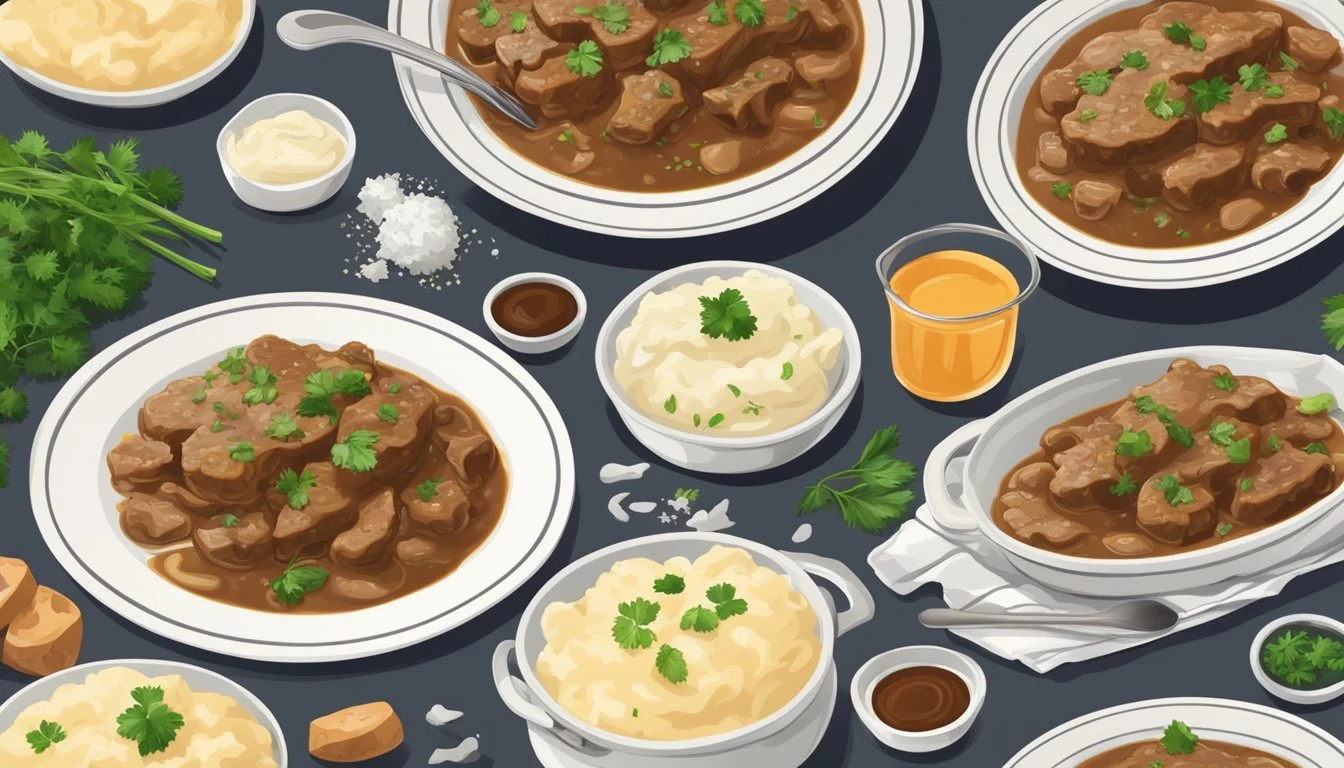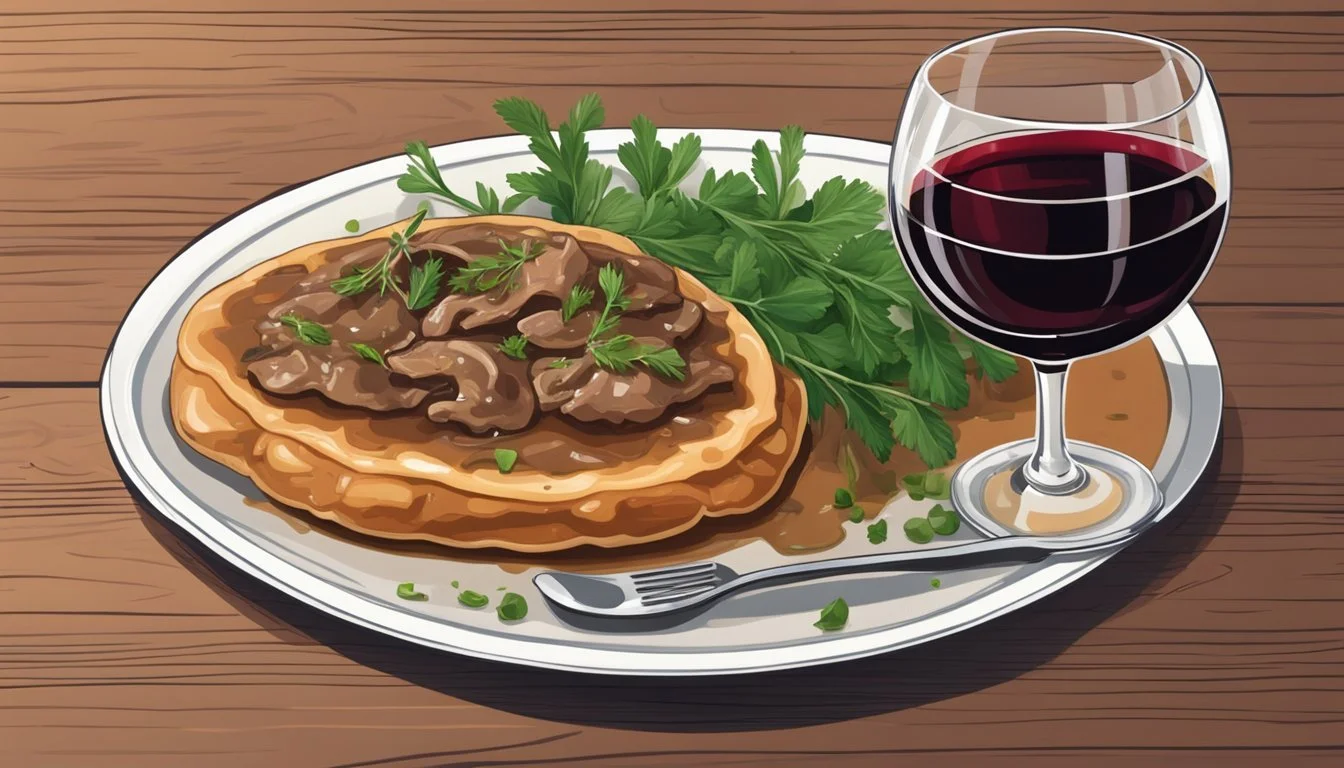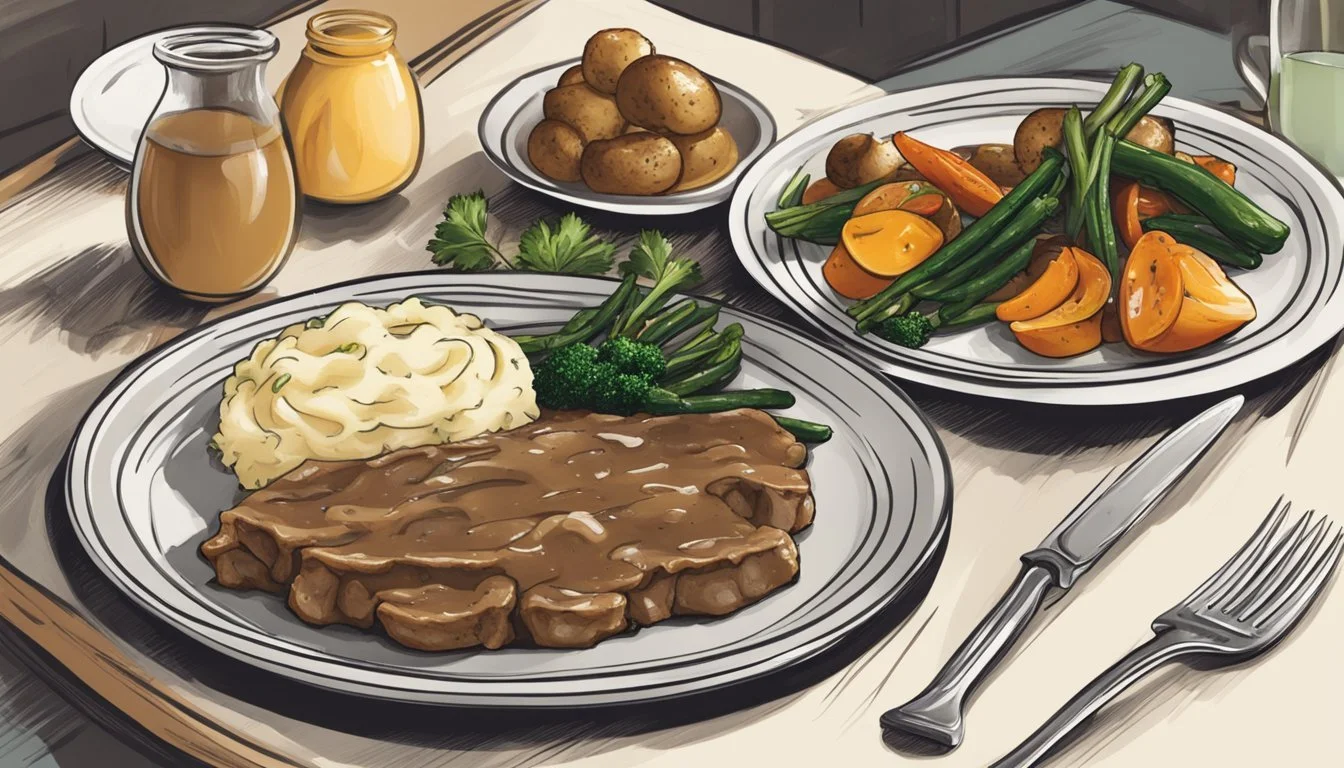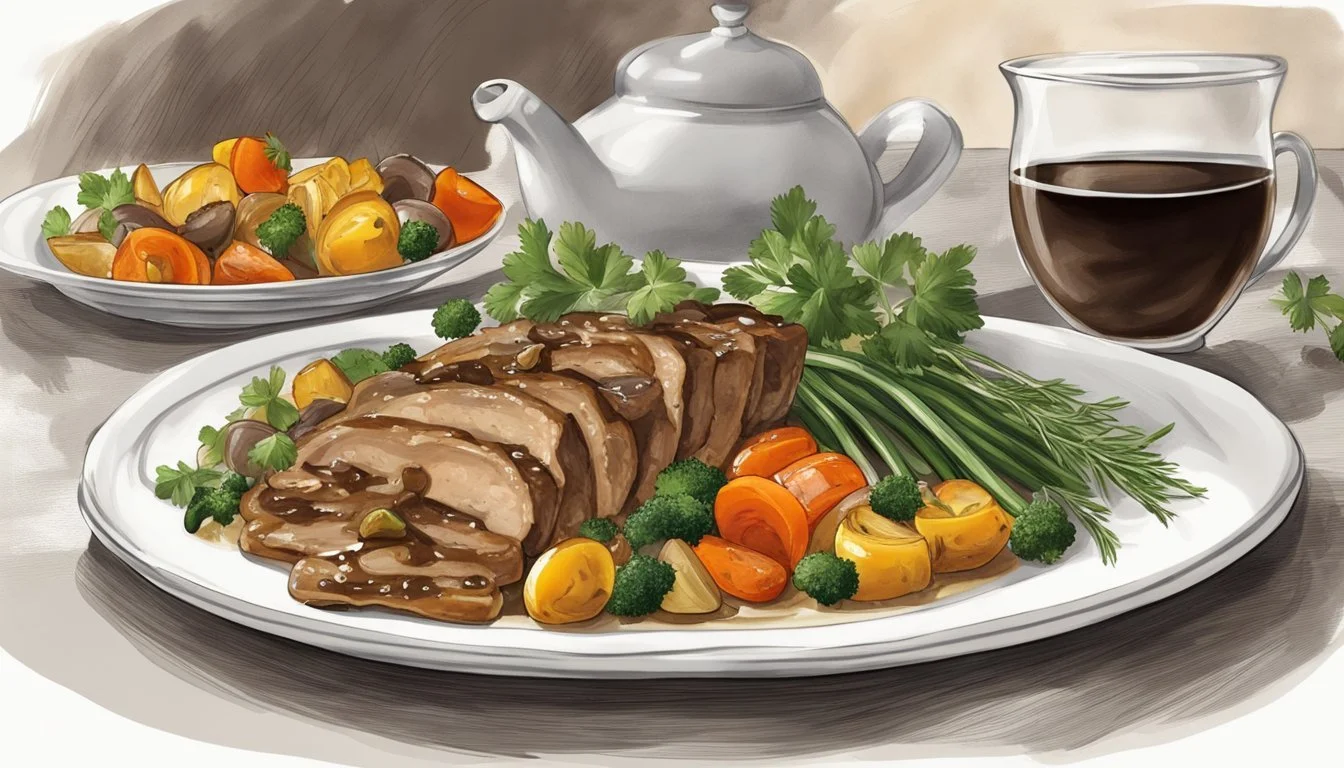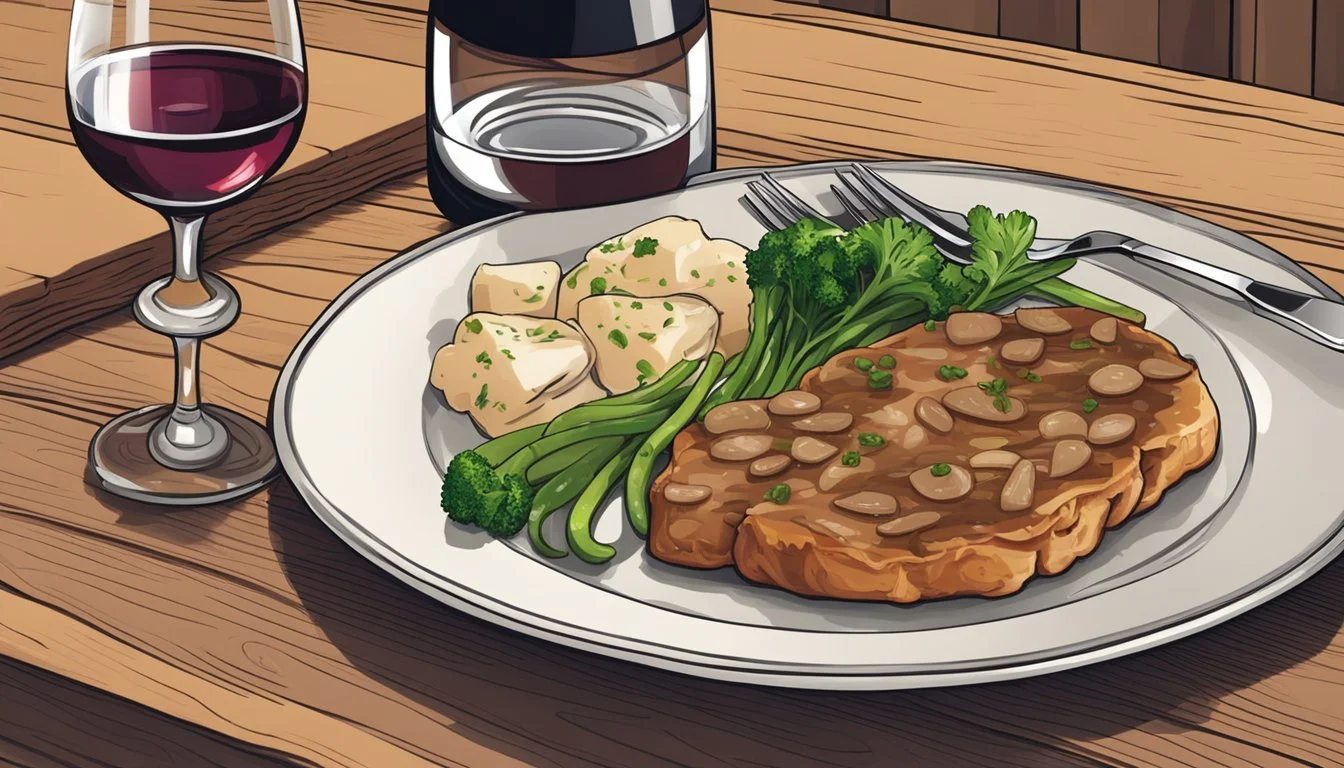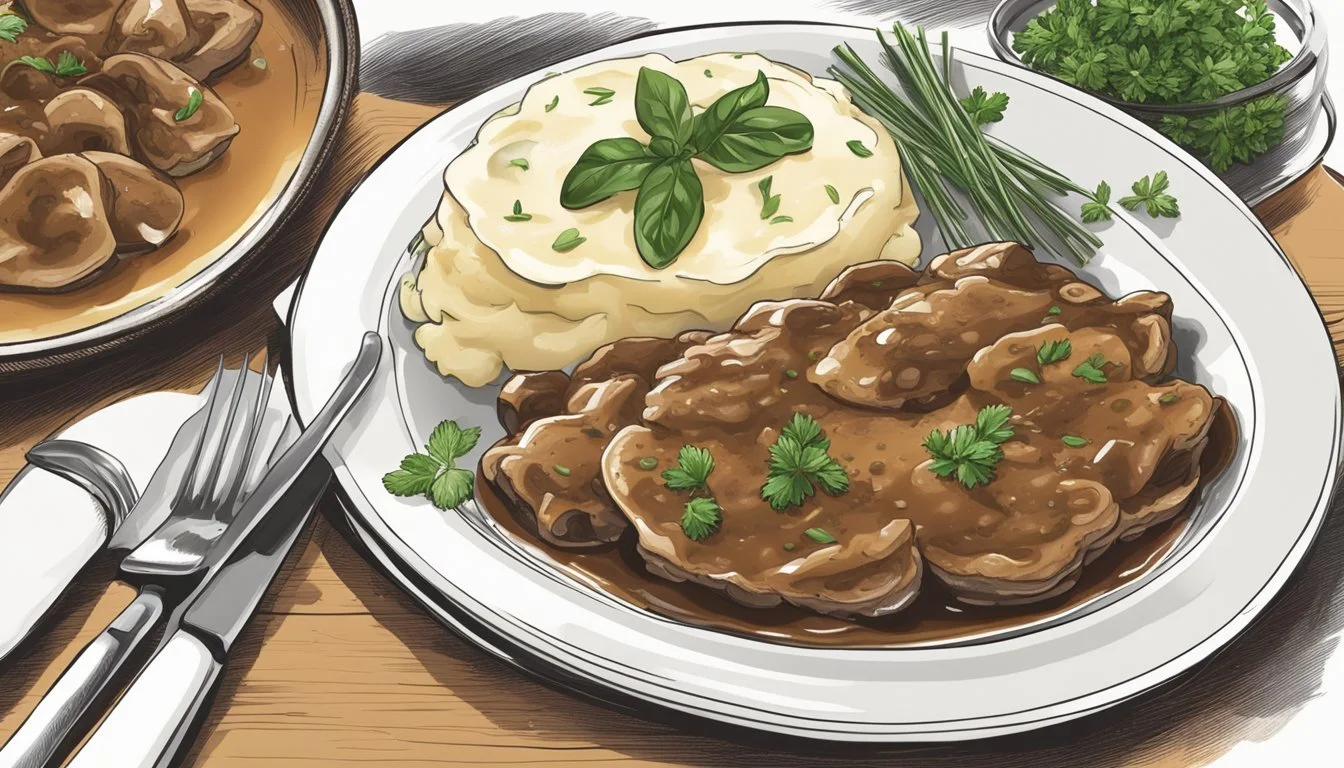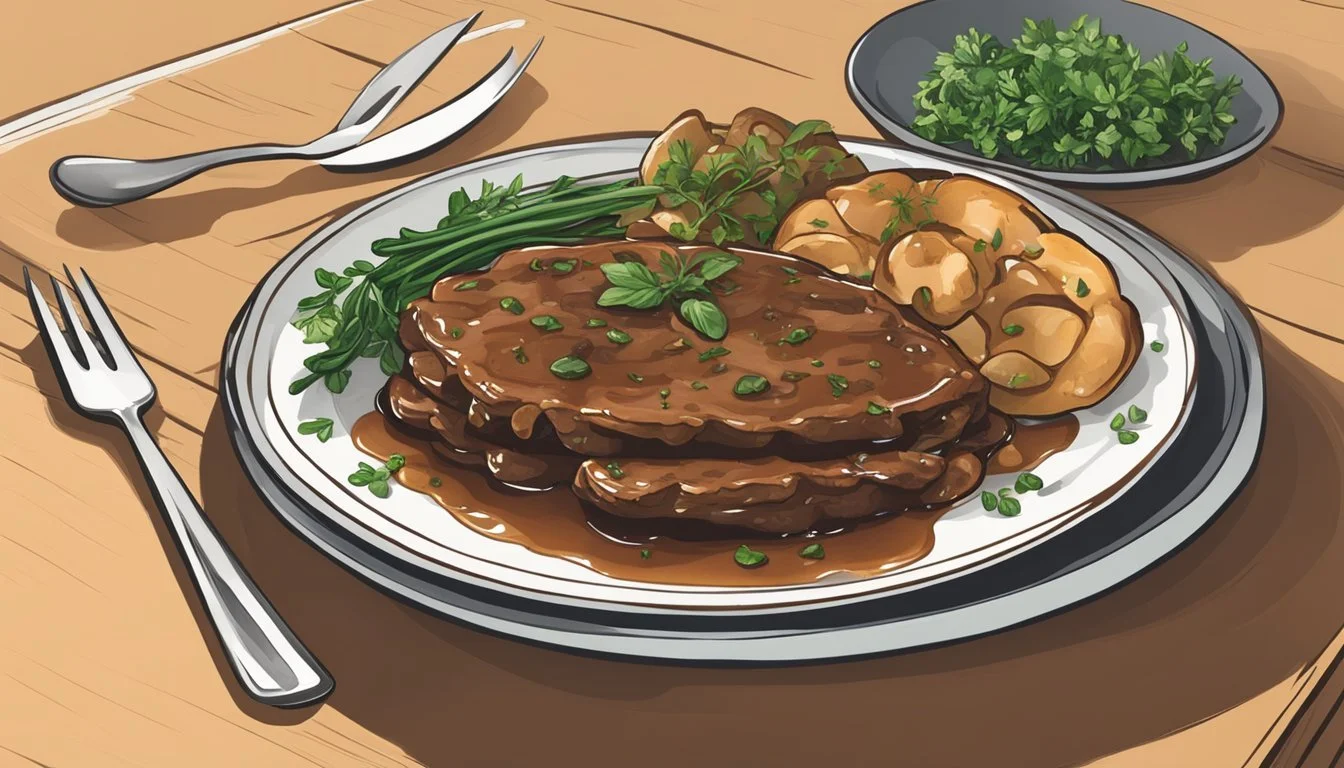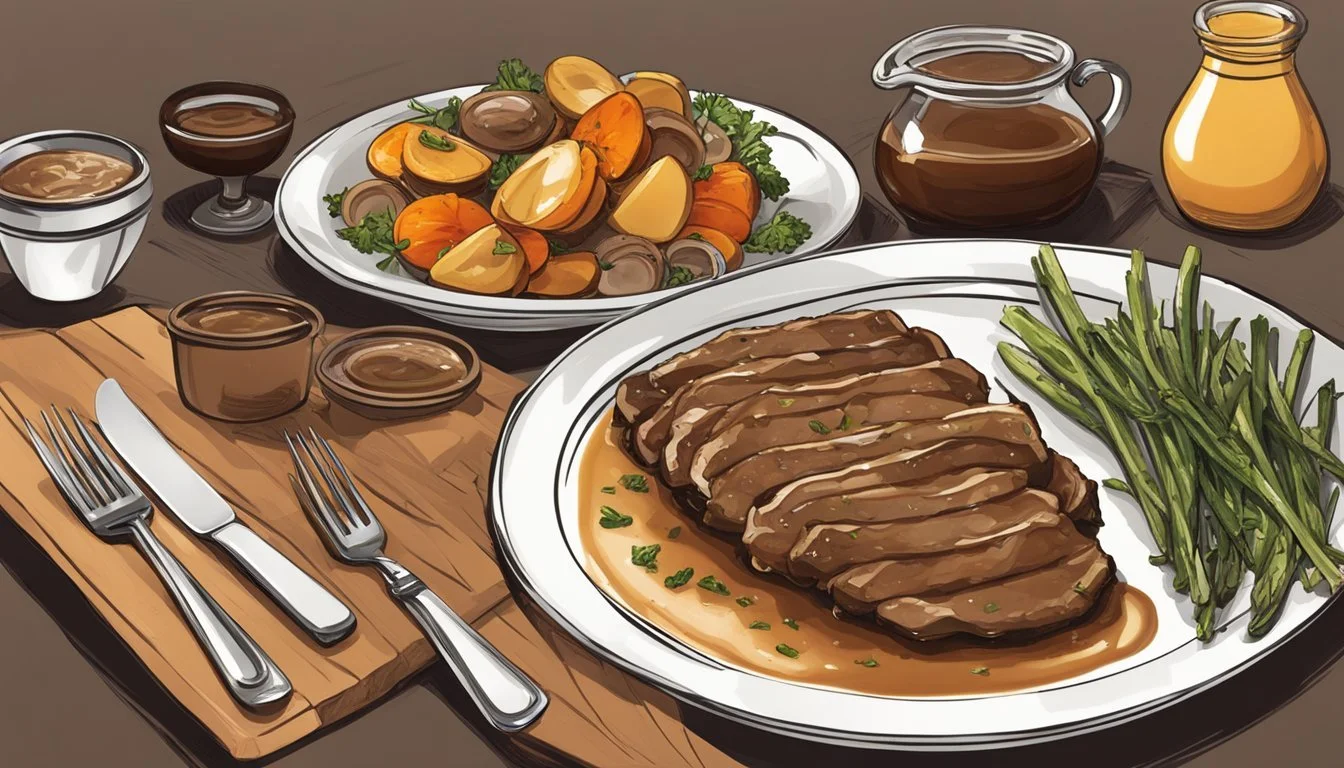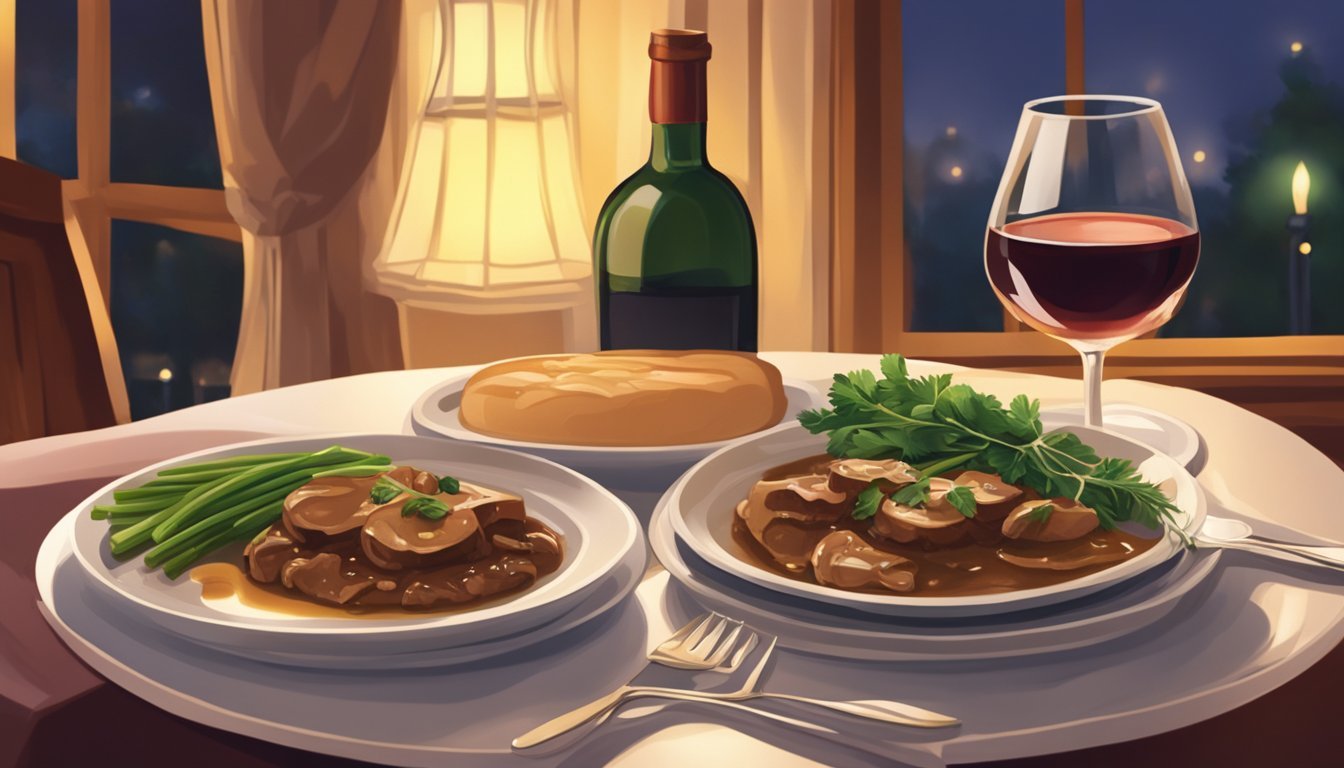How Do You Eat Veal Marsala?
Unveiling the Proper Culinary Approach
Veal Marsala is a classic Italian-American dish that has become a staple in many restaurants and households. The dish's central component is veal cutlets (What wine goes well with veal cutlets?), which are thinly sliced and tenderized from the leg or loin of a young calf. These cutlets are lightly floured before being sautéed to a golden brown. The rich sauce, a defining characteristic of the dish, is made using Marsala wine, a Sicilian fortified wine that imparts a deep, complex flavor profile.
Eating Veal Marsala is an experience that goes beyond simple consumption. It is customarily served with a side that complements the flavors and texture of the veal, such as creamy mashed potatoes or buttered pasta (What wine goes well with pasta?). The dish is often garnished with freshly chopped parsley, adding a touch of color and freshness. Mushrooms, another common ingredient, enhance the umami in the dish. When consuming Veal Marsala, it is typical to have each bite of the veal together with a bit of the sauce and the side dish to enjoy the full spectrum of tastes and textures.
Origins of Veal Marsala
Veal Marsala is a dish steeped in Sicilian tradition, deeply rooted in Italian cuisine and often associated with the warmth of Italian restaurants.
Historical Background in Sicily
In the sun-drenched island of Sicily, located at the southern tip of Italy, Veal Marsala made its first culinary appearance. While the exact historical origins are often debated, it is generally agreed that the dish evolved from the practice of cooking meat in fortified wine. This practice dates back centuries, with local variations emerging across Italy.
Marsala wine, which is integral to the recipe, takes its name from the Sicilian city of Marsala. The British influence on the local wine production in the 18th century led to the fortification of Marsala wine to ensure it endured the sea journey to England. Sicilians started incorporating this wine into their cooking, and Veal Marsala is a delicious testament to this practice.
The dish gained popularity in Sicilian cuisine before making its way to the Italian mainland, and eventually to Italian restaurants around the world. Chefs in Sicily would pan-fry thin slices of veal and create a rich sauce using Marsala wine, often incorporating mushrooms and onions. It became known for its delicate balance of flavors and the tender veal scaloppine—a term for thinly sliced cuts of meat pounded or thinly sliced.
The popularity of Veal Marsala can be attributed to its confluence of local ingredients, cultural exchange, and simple, rustic preparation that highlights the natural flavors of the region. In essence, Veal Marsala is a culinary representation of Sicily's agricultural and enological bounty, with the tender veal symbolizing the island's pastoral traditions, and the Marsala wine showcasing its viticultural prowess.
Essential Ingredients
For a classic Veal Marsala, the following ingredients are crucial to capture the distinct flavors and textures of this Italian-American dish:
Meat:
Veal Cutlets: Thin slices of veal are essential; they should be tenderized until they are evenly thin to ensure quick and even cooking.
Flavorings:
Kosher Salt and Freshly Ground Black Pepper: These seasonings enhance the natural flavors of the veal.
Garlic and Shallots: Finely minced, they contribute to the aromatic base of the sauce.
Fats:
Unsalted Butter and Olive Oil: A combination of these fats is used for frying the veal and creating a rich sauce.
Liquids:
Marsala Wine: A sweet fortified wine from Sicily that lends a caramelized richness to the dish.
Chicken or Veal Stock: Used to add depth and body to the sauce.
To Thicken and Enrich:
All-Purpose Flour: This is used to dredge the veal cutlets and contributes to thickening the sauce.
Heavy Cream (optional): For a richer, creamier sauce, some recipes include a splash of heavy cream.
Vegetables and Herbs:
Mushrooms: Typically, button or cremini mushrooms are sliced and sautéed until tender.
Fresh Parsley: Chopped parsley is sprinkled on top for a burst of color and fresh flavor.
These ingredients come together to create a dish where the veal is pan-fried to golden perfection and then simmered in a savory, slightly sweet Marsala sauce. The result is an exquisite balance of flavors and textures that define Veal Marsala.
Preparing the Veal Cutlets
Before cooking Veal Marsala, the veal cutlets require careful preparation to ensure they absorb flavors and achieve a delectable sear. The process begins with proper dredging in seasoned flour followed by searing in a pre-heated skillet.
Dredging in Flour
The foundation of a flavorful veal cutlet lies in its dredging process. First, each veal cutlet should be evenly seasoned with salt and pepper. After the cutlets are seasoned, they are lightly dredged in all-purpose flour. This step accomplishes two things: it helps in creating a slightly crispy outer layer and manages to thicken the sauce later on. It's essential to shake off any excess flour to prevent a gummy texture.
Step 1: Season cutlets with salt and pepper.
Step 2: Lightly coat with all-purpose flour.
Achieving the Perfect Sear
After dredging, the cutlets are introduced to a hot skillet with a thin layer of olive oil or extra virgin olive oil. This oil should be heated to a point where it shimmers but does not smoke, indicating it is ready for the cutlets. The cutlets should be laid into the skillet without overcrowding to ensure even cooking and a flavorful, golden-brown sear.
Olive oil Temperature: Hot but not smoking.
Cooking: Careful not to overcrowd the skillet.
Each side typically requires about 2 minutes of cooking time to achieve the perfect color and texture. After the cutlets reach a golden-brown sear, they are set aside and kept warm. The seasoned flour residue left behind will contribute to the Marsala sauce's depth of flavor, making each bite of veal cutlet rich and enjoyable.
Creating the Marsala Sauce
The Marsala sauce is a rich and flavorful accompaniment to veal and is characterized by its use of Marsala wine, mushrooms, and chicken broth. It's the heart of the veal Marsala dish, where the depth of flavor develops.
Cooking the Mushrooms
To begin, one should sauté mushrooms in a combination of butter and oil until they are tender. It's important to clean the mushrooms with a damp cloth and to thinly slice them before adding to the pan. Seasoning with salt and pepper during cooking enhances their natural flavor.
Deglazing with Marsala Wine
Once the mushrooms are cooked, Marsala wine is added to the pan to deglaze, which means to pour the Marsala into the hot pan to loosen the browned bits of food on the bottom. The cook should allow the wine to simmer and reduce by half to concentrate the flavors and cook off the alcohol, leaving behind the sought-after Marsala wine sauce essence.
Finishing the Sauce
To finish the sauce, the recipe calls for the introduction of chicken broth or stock to add a savory dimension. Once the broth is added, the sauce needs to simmer for a short period to allow it to thicken. Optionally, stirring in a small amount of flour can aid in thickening the sauce. For a richer, more decadent sauce, heavy cream can be included at this stage. Garlic is also often sautéed with the mushrooms to infuse the sauce with additional flavor. The sauce should be kept warm until it is time to return the veal to the pan to reheat and coat with the sauce before serving.
Combining Elements
In the creation of Veal Marsala, the process of simmering the veal within the Marsala wine sauce is crucial to achieving a tender and flavorful dish. A final touch of garnishing with parsley not only adds a burst of color but also introduces a fresh, herbal contrast to the rich sauce.
Simmering the Veal in Sauce
Once the veal cutlets have been browned to perfection, they are returned to the pan to simmer in the Marsala wine sauce. This step is essential because it allows the meat to absorb the flavors of the sauce, which includes marsala wine, a fortified wine known for its rich sweetness, and mushrooms, which contribute an earthy taste and hearty texture. The simmering should be done gently to keep the veal tender and to allow the sauce to thicken just enough to coat the meat properly.
Brown veal cutlets in the pan.
Remove veal and add garlic and mushrooms to the pan; sauté until tender.
Deglaze the pan with Marsala wine and simmer until the sauce starts to thicken.
Return the veal to the pan to warm through and let the sauce reduce to a desirable consistency.
Garnishing with Parsley
Once the dish is fully cooked, a final step to enhance Veal Marsala is the addition of freshly chopped parsley. This simple yet effective garnish does not only give the dish a pop of color but also provides a fresh counterpoint to the creaminess of the sauce.
Sprinkle a generous amount of chopped parsley over the veal before serving.
Ensure the parsley is fresh and finely chopped for the best texture and flavor distribution.
The integration of the parsley must be done as the dish is about to be served, maintaining the brightness of the herb and its potent aroma, which should stand out against the backdrop of the savory Marsala wine sauce.
Pairing with Sides
Choosing the right side dishes for veal marsala enhances the overall dining experience by complementing the flavors and textures of this classic dish.
Traditional Accompaniments
Creamy Mashed Potatoes: They are a quintessential pairing for veal marsala. Their creamy texture balances the richness of the marsala sauce, making for a harmonious blend.
Buttered Noodles or Pasta: A side of pasta, such as fettuccine or linguine, gently tossed in butter allows the marsala sauce to shine when it mingles with the pasta's subtle flavor.
Risotto or Creamy Polenta: These rice-based dishes bring an Italian flair to the table. They sop up the flavorful marsala wine sauce, ensuring that none goes to waste.
Alternative Side Dishes
Roasted Potatoes: Cubed and seasoned with rosemary, these roasted potatoes offer a crispy contrast to the tender veal.
Green Beans: Lightly sautéed green beans provide a crisp, fresh counterpoint to the veal's savory depth.
For a dinner that is varied in texture and flavor, one can consider pairing veal marsala with both traditional and alternative side dishes, customizing the meal to personal tastes and dietary preferences.
Serving and Presentation
When serving Veal Marsala, presentation is key to enhancing the dining experience. The dish should be served hot, with the sauce thickened to the right consistency and the meat tender and flavorful. Garnishing with fresh herbs such as parsley or thyme adds a touch of color and a subtle hint of freshness.
Plating Techniques
Veal Marsala should be plated with care to showcase its appetizing appearance. Begin by placing a generous portion of the veal in the center of a warm plate. Spoon the rich Marsala sauce over the meat, allowing some to pool around it for visual appeal. A sprinkle of fresh, finely chopped parsley or thyme not only adds a vibrant contrast but also a burst of herby aroma. For a professional touch, one can use a clean cloth to wipe any splashes or drips off the rim of the plate.
Portion Sizes
Standard portion sizes for Veal Marsala typically range from 4 to 6 ounces of veal per serving. Accompanying the veal, one should allocate approximately a quarter to a third of a cup of the Marsala sauce, ensuring there is enough to enjoy with each bite of veal. If serving as part of a multi-course meal, err on the side of smaller portions to leave room for other dishes. When Veal Marsala is the star of the meal, larger portions can transform the dish into a comforting, satisfying entree.
Nutritional Information
Veal Marsala is a rich dish with nuanced flavors and ingredients contributing to its overall caloric content. Generally, one serving size, which typically amounts to one slice with sauce, contains approximately 268 calories. It's crucial for diners to understand that this number can vary depending on the serving size and any additional ingredients used in the recipe.
Typical Nutritional Breakdown per Serving:
Calories: 268
Protein: Offering an adequate amount of protein, essential for muscle repair and growth.
Fats: Contains fats which should be consumed in moderation as part of a balanced diet.
Carbohydrates: Present in a modest amount, primarily contributed by the Marsala wine and any flour used for thickening the sauce.
Servings are generally in the region of 1 slice with sauce, but this can differ in restaurants or if one is serving the dish at home. Diners may opt for smaller or larger portions based on their nutritional needs or dietary restrictions.
For those tracking daily intake, they should note that 2,000 calories per day are often used for general nutrition advice; therefore, a single serving of Veal Marsala would constitute a smaller fraction of an average daily caloric intake. It should be balanced with other meals throughout the day that provide necessary nutrients and adequate caloric values to meet an individual's dietary needs.
Additionally, the sauce, which often contains butter, flour, and Marsala wine, can be adjusted to suit dietary preferences or restrictions. Using lower-fat alternatives or reducing the sauce portion can impact the total caloric content.
Adapting the Recipe
When preparing veal marsala, one has the flexibility to modify the recipe to suit different protein preferences or dietary requirements without compromising the integrity of the dish's rich flavors.
Substituting Different Proteins
Chicken: An excellent alternative to veal, chicken cutlets can be used to achieve a similar texture and flavor profile. They should be cooked until golden, approximately 2 minutes per side, before adding the marsala sauce.
Pork: Pork tenderloins (What wine goes well with pork tenderloin?), thinly sliced into medallions, adapt well to the marsala wine reduction. Ensure they are cooked thoroughly, as pork requires a longer cooking time than veal.
Turkey: Turkey cutlets serve as a lighter substitute and should be pan-seared until just cooked through to prevent them from drying out.
When using these substitutes, ensure that the proteins are cooked to the recommended internal temperature for food safety: chicken and turkey should reach 165°F, and pork should be cooked to at least 145°F.
Adjusting for Dietary Restrictions
For those following a low-sodium diet, using low-sodium chicken broth instead of traditional chicken or beef stock in the marsala sauce is advisable. This substitution helps maintain the dish’s flavor while controlling the sodium content.
In recipes calling for veal saltimbocca that may contain prosciutto or other high-sodium components, it is important to adjust the remaining ingredients to account for these saltier elements.
For a vegetarian or vegan adaptation, a rich, savory vegetable broth can replace the chicken or beef stock. While the traditional veal flavor will not be present, the essence of the marsala wine sauce can still be captured beautifully with a well-seasoned broth and the inclusion of umami-rich mushrooms.
Practical Tips and Tricks
When creating the classic Italian dish Veal Marsala, precision in cooking technique and flavor enhancement is essential for the perfect balance in every bite.
Cooking Techniques
The veal should first be seasoned with salt and black pepper to taste. An initial sear in extra virgin olive oil is crucial to lock in the flavors and achieve a golden-brown crust. Typically, the veal is cooked for approximately 2-3 minutes per side until golden. It's best to remove the veal from the pan after searing to prevent overcooking while making the sauce.
For the Marsala sauce:
Sauté garlic for 1 minute to release its aroma before adding liquids.
Deglaze the pan with Marsala wine, ensuring all the browned bits are scraped off the bottom of the pan as this adds depth to the sauce.
Simmer until the liquid has reduced by half, which concentrates the flavor.
Incorporate chicken stock, and simmer until the sauce begins to thicken, generally for 5-7 minutes.
Flavor Enhancements
The Marsala sauce's flavor can be enriched by adding aromatics such as a shallot or fine herbs like rosemary and oregano. To leverage these ingredients:
Sauté the shallot until translucent before adding other ingredients for a subtly sweet undertone.
Use dried herbs in moderation to complement, not overpower, the delicate taste of veal.
A few more tips:
Always use fresh garlic cloves as the pre-minced ones may lack in flavor.
Reintroduce the veal into the pan to warm through and absorb the Marsala sauce.
Finish with a sprinkling of freshly chopped parsley for color and a fresh flavor note.
Storing Leftovers
Proper storage is crucial for maintaining the quality of Veal Marsala leftovers. Leftovers should be promptly stored to prevent spoilage and ensure safety when they are enjoyed later.
Refrigeration
Leftovers should be placed in the fridge within two hours of cooking to prevent bacterial growth. Veal Marsala should be stored in an airtight container or tightly wrapped in foil or plastic wrap. It is recommended to consume refrigerated Veal Marsala within three to four days for the best quality.
Freezing Options
For longer storage, Veal Marsala can be frozen. To freeze, one should:
Let the Veal Marsala cool to room temperature.
Transfer it to a freezer-safe container or wrap it securely in foil and then place it in a freezer bag.
Label with the current date, as leftovers should be used within two to three months for optimal taste and quality.
Reheating for Best Quality
When reheating Veal Marsala, the goal is to reach an internal temperature of 165°F to ensure food safety.
For the microwave: Cover the leftovers with a microwave-safe lid or vented wrap to maintain moisture. Heat in intervals, stirring when possible.
In the oven: Place Veal Marsala in an oven-safe dish, cover with foil to prevent drying, and reheat at 350°F until the desired temperature is reached.
On the stovetop: Reheat gently in a skillet, adding a splash of water or broth if necessary to keep the dish moist.
By following these storage and reheating procedures, one can enjoy Veal Marsala leftovers that maintain their flavor and texture.
Related Dishes
Veal Marsala, with its rich and aromatic sauce, shares culinary ties with a range of Italian dishes that either utilize Marsala wine or celebrate the tender cutlets of veal in other forms.
Other Marsala Variations
Chicken Marsala (What wine goes well with chicken marsala?) stands out as a popular alternative for those who prefer poultry. It mirrors the method of the veal version but substitutes chicken breast for the veal medallions. The chicken is typically pounded flat, dredged in flour, and then pan-fried. After sautéing mushrooms and adding Marsala wine to deglaze the pan, the resulting sauce is poured over the cooked chicken.
Another variation can be found in Scaloppine al Marsala, which refers broadly to thinly sliced meats, such as chicken, veal, or sometimes pork, cooked in Marsala wine sauce.
Similar Italian Specialties
Veal Saltimbocca embodies a classic Roman dish and is another veal centric recipe. Here, thinly sliced veal is topped with prosciutto and sage, and often marinated in wine or seasoned with various herbs.
In another corner of Italian cuisine, braised veal shanks, otherwise known as Ossobuco, present a heartier, slow-cooked dish where the meat is braised with vegetables and broth, often served with risotto.
For those exploring the scope of traditional Italian dishes involving veal, these cousins of Veal Marsala offer a flavorful journey through Italy's rich culinary landscape.
Veal Marsala at Home
Preparing Veal Marsala at home combines the tenderness of veal with the rich flavors of Marsala wine and mushrooms. It’s a dish that can transport the home cook straight to an Italian restaurant experience, whether on busy weeknights or for a special date night dinner.
Selecting the Right Equipment
The key to a successful Veal Marsala lies in the cooking technique, and that begins with the right equipment. One will need:
A large skillet, preferably non-stick or a well-seasoned cast iron. The skillet should be able to accommodate the veal without overcrowding, allowing each piece to brown properly.
A set of tongs to safely flip the veal cutlets.
Measuring cups for precise liquid measurements, such as the Marsala wine and chicken stock.
A sharp knife and cutting board for preparing ingredients like garlic and mushrooms.
Planning for Dinner Events
When planning Veal Marsala for dinner events, one should consider the following:
For busy weeknights:
Prep Ahead: Chop garlic and mushrooms ahead, keeping them refrigerated until ready to use.
To simplify the process, it might be helpful to have all the ingredients measured and placed in separate dishes known as mise en place.
For date night or special occasions:
Pair the dish with a complementary side such as mashed potatoes, polenta, or a simple green salad.
Wine pairing can elevate the experience; select a wine that complements the Marsala sauce, such as a medium-bodied red or a crisp white.
Conclusion
Veal Marsala is traditionally enjoyed as a main course and is best served hot, with its rich and flavorful sauce directly off the stove. It is commonly accompanied by a side of starch, like buttered noodles or creamy mashed potatoes, which complement the savory notes of the Marsala wine reduction. For a balanced meal, one might also consider a side of steamed vegetables or a fresh garden salad.
Portioning the veal onto plates is straightforward; chefs recommend a serving of one to two scaloppine per person, spooning the reduced sauce and mushrooms over the top. A light garnish of chopped parsley not only adds a pop of color but a subtle fresh flavor that cuts through the dish's richness.
For those looking to pair a drink with Veal Marsala, a glass of Marsala wine itself is a traditional choice, although any medium-bodied red wine or even a crisp white wine can serve as a suitable accompaniment, enhancing the dining experience.
When indulging in this Italian-American classic, the flavors of the dish should be savored slowly, allowing for the appreciation of the delicate balance between the tender veal, the aromatic sauce, and the earthiness of mushrooms. This dish reflects the essence of Italian cuisine, where simplicity meets sophistication in a harmonious blend.



